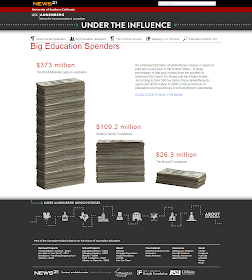An estimated $4 billion of philanthropic money is spent on education each year in the United States. A large percentage of that pool comes from the pockets of reformers Bill Gates, Eli Broad and the Walton family. According to their 990 tax forms, these philanthropists spent over $500 million in 2009 on the promotion of education reform practices in school districts nationwide.
CLICK EACH STACK FOR MOREDeep-Pocket Reformers: The Shadow Secretaries of Education
In advancing some interests, foundations have inevitably not advanced others. Hence, their actions must have political consequences, even when political purposes are not avowed or even intended. To avoid politics in dealing with foundation history is to miss a crucial part of the story. —Ellen Lagemann, Private Power for the Public Good

Gates is not the only billionaire who has decided to make education reform one of his pet projects. Los Angeles–based developer Eli Broad, the mega-rich Walton family (founders of Walmart) and other philanthropists currently give some $4 billion a year in contributions to education.
But these handouts are hardly purely philanthropic. They come tied with policy strings and a well-defined agenda.
While not the only donors, Gates, Broad and the Waltons have emerged as the highest-profile deep-pocket benefactors of what has become a nationwide education reform movement.
Though this push for reform of public schools dates back several decades, it has steadily moved from the margins of the political debate to occupy center stage in the tussles over domestic policy. The influence that these private philanthropists exercise is now being felt in school districts from coast to coast and manifests itself in the policies favored by the donors: the introduction of a corporate model in school administration, merit pay for teachers, giving local schools greater autonomy from their respective districts and the opening of more charter schools.
In these uncertain economic times where American families put an ever-higher premium on a good education, and with

